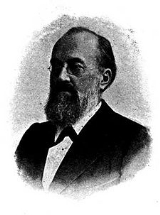
Ewald Hering
Encyclopedia
Karl Ewald Konstantin Hering (August 5, 1834 – January 26, 1918) was a German
physiologist who did much research into color vision
and spatial perception. His uncle was the homeopath Constantine Hering
.
Born in Alt-Gersdorf, Kingdom of Saxony
, Hering studied at the University of Leipzig
and became a professor at Charles University in Prague
.
and Hermann von Helmholtz
. Helmholtz's theory stated that the human eye perceived all colors in terms of three primary color
s: red, green, and blue. Hering instead believed that the visual system worked based on a system of color opponency
. Both proposals are now widely recognized as correct in different aspects of color perception.
Hering looked more at qualitative aspects of color
and said there were six primary colors, coupled in three pairs: red–green, yellow–blue and white–black. Any receptor that was turned off by one of these colors, was excited by its coupled color. This results in six different receptors. It also explained afterimage
s.
which now bears his name – Hering illusion
. He also developed Hering's law of equal innervation
to describe the conjugacy of saccades in animals.
The Hering–Breuer reflex is also named for him.
Germany
Germany , officially the Federal Republic of Germany , is a federal parliamentary republic in Europe. The country consists of 16 states while the capital and largest city is Berlin. Germany covers an area of 357,021 km2 and has a largely temperate seasonal climate...
physiologist who did much research into color vision
Color vision
Color vision is the capacity of an organism or machine to distinguish objects based on the wavelengths of the light they reflect, emit, or transmit...
and spatial perception. His uncle was the homeopath Constantine Hering
Constantine Hering
Constantine Hering was an early pioneer of homeopathy in the United States.-Biography:Hering was born in Oschatz, Saxony, and studied medicine at the University of Leipzig where his conversion to homeopathy occurred...
.
Born in Alt-Gersdorf, Kingdom of Saxony
Kingdom of Saxony
The Kingdom of Saxony , lasting between 1806 and 1918, was an independent member of a number of historical confederacies in Napoleonic through post-Napoleonic Germany. From 1871 it was part of the German Empire. It became a Free state in the era of Weimar Republic in 1918 after the end of World War...
, Hering studied at the University of Leipzig
University of Leipzig
The University of Leipzig , located in Leipzig in the Free State of Saxony, Germany, is one of the oldest universities in the world and the second-oldest university in Germany...
and became a professor at Charles University in Prague
Charles University in Prague
Charles University in Prague is the oldest and largest university in the Czech Republic. Founded in 1348, it was the first university in Central Europe and is also considered the earliest German university...
.
Color theory
Hering disagreed with the leading theory developed mostly by Thomas YoungThomas Young (scientist)
Thomas Young was an English polymath. He is famous for having partly deciphered Egyptian hieroglyphics before Jean-François Champollion eventually expanded on his work...
and Hermann von Helmholtz
Hermann von Helmholtz
Hermann Ludwig Ferdinand von Helmholtz was a German physician and physicist who made significant contributions to several widely varied areas of modern science...
. Helmholtz's theory stated that the human eye perceived all colors in terms of three primary color
Primary color
Primary colors are sets of colors that can be combined to make a useful range of colors. For human applications, three primary colors are usually used, since human color vision is trichromatic....
s: red, green, and blue. Hering instead believed that the visual system worked based on a system of color opponency
Opponent process
The color opponent process is a color theory that states that the human visual system interprets information about color by processing signals from cones and rods in an antagonistic manner...
. Both proposals are now widely recognized as correct in different aspects of color perception.
Hering looked more at qualitative aspects of color
Color
Color or colour is the visual perceptual property corresponding in humans to the categories called red, green, blue and others. Color derives from the spectrum of light interacting in the eye with the spectral sensitivities of the light receptors...
and said there were six primary colors, coupled in three pairs: red–green, yellow–blue and white–black. Any receptor that was turned off by one of these colors, was excited by its coupled color. This results in six different receptors. It also explained afterimage
Afterimage
An afterimage or ghost image or image burn-in is an optical illusion that refers to an image continuing to appear in one's vision after the exposure to the original image has ceased...
s.
Other research
In 1861 Hering described an optical illusionOptical illusion
An optical illusion is characterized by visually perceived images that differ from objective reality. The information gathered by the eye is processed in the brain to give a perception that does not tally with a physical measurement of the stimulus source...
which now bears his name – Hering illusion
Hering illusion
The Hering illusion is a one of the geometrical-optical illusions and was discovered by the German physiologist Ewald Hering in 1861 . Two straight and parallel lines look as if they were bowed outwards. The distortion is produced by the radiating pattern and was ascribed by Hering to an...
. He also developed Hering's law of equal innervation
Hering's law of equal innervation
Hering's law of equal innervation is used to explain the conjugacy of saccadic eye movement in stereoptic animals. The law proposes that conjugacy of saccades is due to innate connections in which the eye muscles responsible for each eye's movements are innervated equally...
to describe the conjugacy of saccades in animals.
The Hering–Breuer reflex is also named for him.

